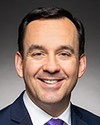I have to stop you there. We're over time.
We'll move now to Ms. Bennett for the next seven minutes.
Evidence of meeting #40 for Indigenous and Northern Affairs in the 41st Parliament, 2nd Session. (The original version is on Parliament’s site, as are the minutes.) The winning word was need.
A recording is available from Parliament.
9:25 a.m.
Conservative

The Chair Conservative Blake Richards
I have to stop you there. We're over time.
We'll move now to Ms. Bennett for the next seven minutes.
9:25 a.m.
Liberal

Carolyn Bennett Liberal St. Paul's, ON
Thanks very much.
First, Chief Moody, in this committee's previous study on land management, I underlined the need for additions to reserve to be moved in a much more timely fashion. For us to make a recommendation in this study, it would be good if you could explain how when that slows down, it reduces your ability to access capital. Can you join those two things for us so they can be part of the report?
9:25 a.m.
Chairperson, Business Development Committee, Community Futures North Central Development
We've been involved in a lot of major economic development projects in our community. We're involved with a hydro partnership, obviously, with Manitoba Hydro. We own a third of a $1.6 billion project and we had to provide $20 million of our own money to be a partner in the hydro development project in our community.
We also have a grocery store in Thompson, a grocery store we just opened about a year and a half ago. We have our Mystery Lake property, which is located right in Thompson. That's a property that I think can work in Thompson. We're also building a new store in our own community to replace the Northern store that was previously in our community.
The restriction on our ability to access capital as a result of the property not being converted has been so frustrating. We've tried everything within our power to convert this property. Even with the TLE lands that have a legal obligation to convert the property or lands into reserve, that's been really cumbersome and slow as well.
So in terms of recommendations, I don't know how to make it quicker. I think the regions have to be more responsive. There are templates that are changing over time. We don't even get the information on what the policies are and the changes in them. People in the region don't understand what's happening in the headquarters, so there's a disconnect between headquarters and the regions.
Based on my experience, I don't know all the details of what's happened. Even the people in the region don't understand what the changes are when they happen, so they have to wait on what headquarters has to say. There's really a lack of communication sometimes between the department and our first nation. For example, when we make phone calls to the region, they don't answer. They don't get back to us. So we have to redo everything, like the environmental studies that have to be redone every two years.
It seems that we spin our wheels and we go back and do the same thing over and over again. That is really frustrating to me, and for us, and we've been really patient. Our philosophy has always been that we have to look after ourselves as a community, that we need to be economically independent, that we need to be economically strong. We know that government's not going to provide the funding we need. As of today, we need $60 million in new infrastructure dollars to rebuild our nation. We spent $20 million of our own money as equity we need for Wuskwatim.
It really impacts the development of our community, but we know that in order for us to rebuild our community, we have to invest economically, and it's so frustrating, especially for other first nations. In Manitoba 75% of our first nations are under some sort of third-party management or remediation and it's really hard for them to access capital from conventional banks. Even when we borrow money from banks to pursue an economic development project, the government has to guarantee those loans, and if something does happen with the minimal amount of money we do have, it can bankrupt our nation.
But, luckily, we were able to do it ourselves. There are other smaller first nations that don't have that capacity and that need to access capital so they can start participating in the mainstream economy. There are only so many gas stations that you can build on their reserves. They need to participate in our economy and resource development. That's really important.
As far as recommendations as to how to speed up that process are concerned, I think the government has to have the will to make those happen, because we're not going to be able to provide all the funding that we need for first nations. Even our first nation, for example, needs $60 million today. We need a new school, we need new water treatment plants, and we need to rebuild our houses. We're short 400 houses in our community and our philosophy has always been, yes, we need to invest economically so we can rebuild our own community.
We've been waiting for a hundred years to get the proper funding that we need from the government. It's not there, but we're doing it ourselves. For me, I think it's the right way, but we need access to capital and that's the bottom line.
9:30 a.m.
Liberal

Carolyn Bennett Liberal St. Paul's, ON
So if this had been declared reserve land eight years ago, your community would have been much better off?
9:30 a.m.
Chairperson, Business Development Committee, Community Futures North Central Development
Absolutely. We would have participated in more and more projects, and it would have expanded the opportunities for our community and the first nations. Maybe we can help other first nations. That is part of the whole scheme that we have. That is our philosophy. We are going to do it ourselves, but we need some help from the federal government, and that is so critical.
Access to capital is so vital. Without the access to capital that we had.... For the Wuskwatim project, we got $4 million from the federal government. That really helped. If it weren't for that, we would never have been able to own 33% of the project.
We have $20 million. We need $150 million to own the Wuskwatim project because the debt-equity ratio for the project is 75-25. If it weren't for Manitoba Hydro and the innovation by them in providing us with the money that we needed for our equity, it wouldn't have been possible for us. Resource developers need to step up to help first nations, to be innovative, and to help with their equity, too. That's really key, and that's what we did for our Wuskwatim development project.
Our future is great. Of course, it depends on the commodity. It goes up and down, and lately it has been really negative, but the future is there. Once we pay off our debt, we are looking at $20 million to $30 million of revenue for our first nation, based on a projection. That's not going to happen for another 30 or 40 years, but at least there is a future for our people. If it weren't for access to capital, that may not have been possible, and we would have been stuck in a perpetual cycle of poverty. It's terrible. It's sad, but that is the reality of a lot of first nations. They need help.
9:30 a.m.
Conservative

The Chair Conservative Blake Richards
Thank you.
We'll move now to Mr. Strahl for the next seven minutes.
9:30 a.m.
Conservative

Mark Strahl Conservative Chilliwack—Fraser Canyon, BC
Thank you.
Mr. Vincent, thank you for the presentation you gave.
In your presentation, you mentioned that we loan to solvent people who will become owners of their houses. We want to make tenants into owners. I want to try to get an idea from you now.... Are we talking about first nations property ownership, which has been advocated by Chief Manny Jules and others, or is there a different model that you are talking about that would allow tenants to become owners, allow people to start to own their property?
9:35 a.m.
President and General Manager, Aboriginal Savings Corporation of Canada
Thank you for the question.
We take our inspiration from the Huron-Wendat First Nation in Wendake, located close to Quebec City. That model inspires us because, in the 1970s, the community of Wendake was quite poor and the houses were small. People took two and three years to build their houses, for as long as they received government grants. The community of Wendake was no different than most of the other communities in Canada.
In the 1970s, the elected council at the time decided to create a housing fund and to lend money to individuals rather than giving them government grants piecemeal. Today, that fund is valued at $30 million. I can tell you that the houses in Wendake are comparable to those in the municipalities that border the community.
I spoke about breaking the cycle of dependence and instead bringing a community into a situation of responsibility. That is exactly what has happened in Wendake over a period of about 40 years. As the housing fund grew, the community was able to make bigger and bigger loans, which allowed people to have more access to capital and therefore to build more comfortable homes that better met their needs. Instead of being all the same, the houses have features that reflect people's own tastes.
Gradually, people became homeowners. Because of that, they have continued to maintain their property, with the result that, today, the community of Wendake is beautiful, with beautiful houses that most of the people own. When they retire, they will have a significant asset at their disposal.
The community of Wendake also worked with financial institutions. First, it was with the credit union in Wendake, then with the Native Commercial Credit Corporation, which is an aboriginal finance company just like the Community Futures North Central Development, represented by other witnesses at this committee. Since 2005, the housing fund has been working in coordination with the Aboriginal Savings Corporation of Canada.
We use the Wendake model as our inspiration and we are reproducing it in other communities that are prepared to make the transition from dependence to more responsibility. At the outset, we want to work with model individuals, those who are solvent and who have good jobs. We feel that, little by little, those individuals will become examples in their communities and will encourage others there to emulate them and achieve the same turnaround.
9:35 a.m.
Conservative

Mark Strahl Conservative Chilliwack—Fraser Canyon, BC
Thank you.
I think that if we have time we should hear from the people of Wendake and learn how they're doing this.
You said you determine the solvency of people by their job. Is that the primary...? Do you determine who gets a loan based on whether they have reliable, good employment?
Their cash flow determines that. Okay.
I'm asking you to speak to a model that you're basing it on. Do those people gain equity like we would outside of the reserve system? They're home owners but I'm assuming there's still an underlying collective nature of the land. Are they able to bank on that asset for commercial loans or to start their own small business for instance?
9:40 a.m.
President and General Manager, Aboriginal Savings Corporation of Canada
With Wendake, we have certainly created a market. The community has a lot of owner-occupiers. Those houses are also in demand. The owner-occupiers who own a home with excellent equity may well be able to use the value of their property to get commercial loans, using the house they own as security.
Does that answer your question?
9:40 a.m.
Conservative

The Chair Conservative Blake Richards
Sorry, unfortunately I have to stop you there.
Mr. Genest-Jourdain, you have seven minutes.
9:40 a.m.
NDP

Jonathan Genest-Jourdain NDP Manicouagan, QC
Thank you, Mr. Chair.
Good morning, Mr. Vincent.
As I mentioned in our previous discussion, I looked at your biography, which dates from 2009. It says that your organization provides financing under commercial conditions to start or expand businesses that are under majority aboriginal control. I imagine that is still the case today.
I studied commercial law in law school. So I can decipher and read a share-capital document. But it does require some special training, which is why most of my constituents are not able to look at the breakdown for any given company.
In my constituency, one of the key aspects of my mandate for the past four years has been the requirement to deal with white-collar crime. We have to call it for what it is. Because of the Plan Nord and the economic boom, a number of companies have been started in my riding in the last four years. The truth is that they are fraudulent; they are shell companies. They use aboriginal people for tax purposes, for income tax. You are aware of the specific rules that apply to an entity that claims aboriginal status.
Some turnkey companies have appeared in the Manicouagan region. They work mostly in natural resource extraction and construction. I am thinking about the La Romaine project, for example. A number of corporate entities popped up overnight. You just have to glance at their share-capital to realize that the leadership, the steering wheel, is not really in the hands of First Nations communities or individuals.
Another situation was brought to my attention by the economic development officers in Manicouagan. In their view, First Nations' participation is often limited to being given tokens—I am not familiar with the concept—that allows them to attend board of directors meetings and even Montreal Canadiens' games, if you can imagine. That is where their participation ends. When these shell companies no longer need their token Indians, if you will excuse the expression, they simply cast them aside. Then it's game over for the company that claimed to be aboriginal when it started.
Mr. Vincent, what protections does your organization have in place in order to keep that kind of embezzlement, those kinds of shell companies, out of your activities?
9:40 a.m.
President and General Manager, Aboriginal Savings Corporation of Canada
Thank you, Mr. Genest-Jourdain.
In terms of commercial loans, we have been working with the Native Commercial Credit Corporation, which has been in existence since 1992. We have issued more than $60 million in loans so far. But our loss rate on the loans is less than 1%. We have a competent team as well as investment and credit policies. That said, from the outset, we screen entrepreneurs for their capability, their reputation and their competence. Whether they are fully aboriginal or have some association with non-aboriginals, it doesn't matter. We still conduct quite a major screening.
As for the problem you mentioned, criminality, we unfortunately have those whom we might as well call crooks. In my opinion, they are taking advantage of the poverty and ignorance among aboriginal people. Generally, as we know, training is a problem among First Nations and, unfortunately, even some of the leaders do not have your competence and expertise, Mr. Genest-Jourdain. If they did, they might understand how deals are organized, how to read financial and share-capital documents to see, in these cases, who the shareholders are and how the system works, with voting shares and non-voting shares and so on.
The crooks sniff out the ignorance and poverty in some communities. They then get the leaders in their pockets, they wine and dine them, fly them around in jets or helicopters, invite them to hockey games, and so on. Unfortunately, only a few leaders in a community get those perks while the whole community is suffering. That leads to situations like the one you describe.
In my opinion, the solution would be to invest more in training leaders. Clearly, we also need to be able to encourage economic development in First Nations communities, to get them out of poverty, to stimulate their economy and to create jobs. It is clear to me that that would largely solve the kinds of problems you are describing.
You were talking about the construction companies in your region, but I can tell you that other initiatives, like Wendake Construction, are working very well. The company has ties to Hamel Construction, a construction company with an exemplary reputation, a company that passes all the Autorité des marchés financiers' tests.
Before it firmed up those ties, Wendake Construction analyzed its partner thoroughly. It made sure that the company was built on solid foundations. It also made sure that training would be provided to Wendake members so that they would not be token Indians, but would genuinely play a role in the management of the company
9:45 a.m.
NDP

Jonathan Genest-Jourdain NDP Manicouagan, QC
Mr. Vincent, I would just like to emphasize that you are one of the only witnesses to have directly addressed this issue in recent years. Thank you for that.
9:45 a.m.
Conservative
9:45 a.m.
Conservative

John Barlow Conservative Macleod, AB
Thank you.
Mr. Johnston, Chief Moody, and Ms. McIvor, thank you very much for coming. I know it's a long journey. I appreciate your being here with us today.
Mr. Johnston, perhaps you could address some confusion I have. You talked about some of the projects that your Community Futures program was investing in, and the jobs, and what not. You also talked about investing in a larger project like the hydro project.
I have several Community Futures programs in my riding. My vision on the mandate of Community Futures is to stimulate start-up businesses, small and medium-sized enterprises. For you to be looking to invest in a substantial project like a hydro project, is that going away from your mandate? Can you explain to me what your vision is there, to be going away from that small and medium-sized business to something that is much larger?
9:45 a.m.
Manager, Community Futures North Central Development
Mr. Chair, good question.
North Central delivers the Community Futures program. We were under contract to serve as an external delivery office, in addition to providing the Community Futures programming. The major contributions were done as an XDO. We hired a separate person to deliver that contract and that programming. I think it was critical.
One of the roles of CFs is to participate or to provide loans. Through the Aboriginal Business Canada program at the time, there had to be a contribution, but then there also had to be lending from conventional lenders. We would often be able to do part of that. The contributions, I spoke to, were through the Aboriginal Business Canada programming XDO contract that we held.
It is no longer in the region and it will create difficulties for first nations to access that funding now.
9:50 a.m.
Conservative

John Barlow Conservative Macleod, AB
Maybe Chief Moody could answer this. Was there not an opportunity to go through the First Nations Finance Authority or the First Nations Bank of Canada? Was this a better option at the time, or were you not able to access those programs to help invest in the hydro project?
9:50 a.m.
Chairperson, Business Development Committee, Community Futures North Central Development
We're able to get loans from wherever we can, but those loans had to be approved by Manitoba Hydro. I don't think we approached those types of lenders, but we're looking for grants. The majority of the loans were provided by Manitoba Hydro itself through an agreement that we had with them. They were leveraged with the amount of money we had. I think the ratio was about one to six. Say we had $20 million, they lend us $120 million. That's the type of agreement we had with Manitoba Hydro, but we never did approach those other industries.
For a typical agency to provide money for NCN, we have to provide a guarantee as a nation and then as a government. I don't think we have that ability or that authority because if something does happen.... People lend us, obviously, on security and if something happens to the project, then they call in that security and it would probably bankrupt our nation. The funding we get is very limited too.
9:50 a.m.
Conservative

John Barlow Conservative Macleod, AB
I understand that. We had witnesses earlier in this study who, for example, were using FNFAs for Ontario Hydro, and they were investing in those types of projects very successfully. I'm just wondering if maybe that is an opportunity for you, if these projects do come up, to take a look at those projects as well.
Mr. Johnston, you talked about having that million dollar nest egg. I guess you're sort of saying that if you could double it, that's what the demand is right now. Do the Community Futures leverage their assets? I know in Alberta they do, but I don't want to say in Manitoba. I know they get together as a group on some larger investments to kind of leverage what they have as a group. Do you do some of that as well?
9:50 a.m.
Manager, Community Futures North Central Development
We can do that. You haven't seen a lot of that in Manitoba. As a Community Futures, we have drawn the most from the Manitoba-pooled funds. One of the challenges obviously in western Canada is the amount of money held by many Community Futures. As I've said, we've borrowed four times from the Manitoba fund in order to access capital. That's really been the only way we've been able to build up our fund, which is excellent for us, although we're borrowing money to lend it again, and that creates some challenges.
We can do joint projects. We haven't done a lot. We borrowed from a CF previously as well.